July 19, 2022
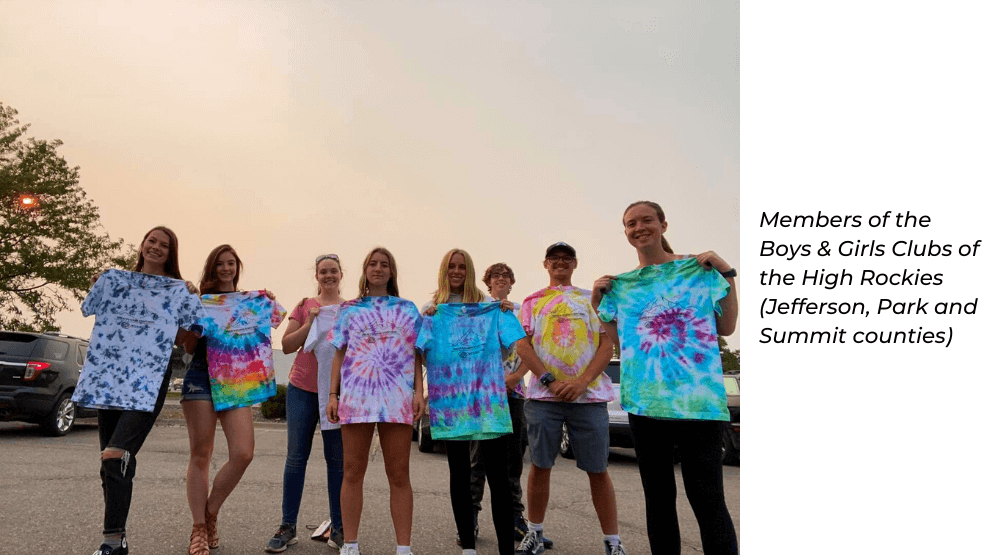
Featured in this Newsletter:
- Boys & Girls Clubs Serve as Vital Resource to Youth Resilience & Well Being
- Pueblo Youth Advisory Council & YouthRoots
COMMUNITY PARTNERS
Boys & Girls Clubs Serve as Vital Resource to Youth Resilience & Well Being
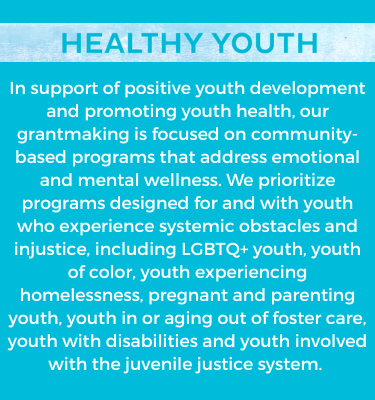
We asked the leaders of three Colorado Boys & Girls Clubs to talk about how they are incorporating social and emotional supports into their programming and why this is so important, especially following the pandemic. Though much of what our community partners had to say wasn’t necessarily surprising, their descriptions of the extent to which COVID-19 has upended the lives of young people is hard to hear. As one said, the assumption was that after two years of the pandemic things would get significantly better, but the behaviors of young people are worse than we’ve ever seen them before – depression, substance misuse, truancy, health concerns and more.
As they navigate this difficult time, they lift up what they are learning works in helping young people to heal, feel safe, be resilient and hopeful for the future. Here’s a summary of what they shared:
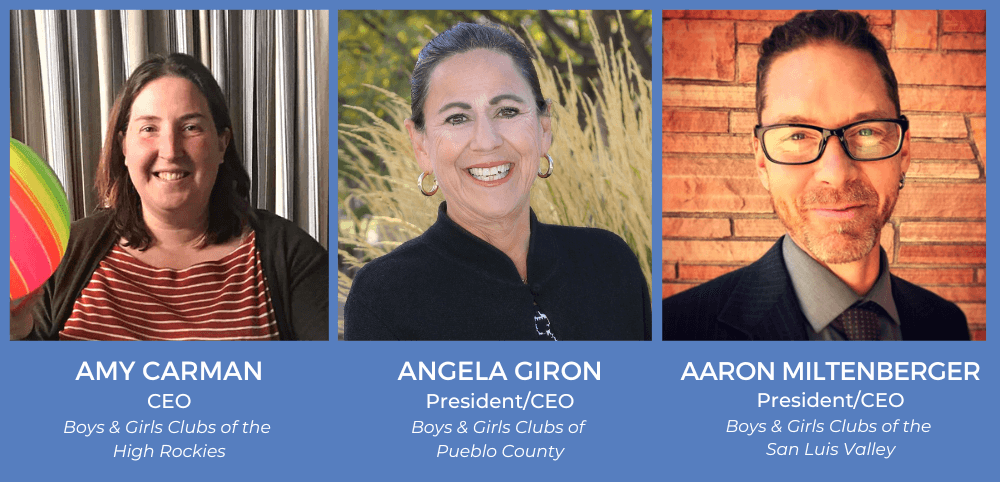
Prioritize youth voice
Ask young people what they need, be responsive, and include them in developing solutions.
Provide adequate coverage and accessibility to social and emotional staff
We now have support at each site – it wasn’t as helpful if someone was having a bad day on Wednesday and the social-emotional coordinator wasn’t available to them until Monday.
Take an integrated approach to therapy
Our providers go on hikes with kids, do art with them, talk in small groups while playing disc golf… and our kids know they are safe with them and that they’re reliable.
Make mental health providers a part of your program
Because our providers are seen as “just another staff member,” it destigmatizes mental health and being cool especially matters to adolescents.
Prioritize the mental health and well-being of staff
Our prioritization of supporting our staff was absolutely critical to their being able to support kids and help families throughout the pandemic; this has resulted in high staff retention.
Align community education, health, and youth-serving supports and services
Don’t ask youth and families to code switch between programs, provide youth with help where and when it’s needed.
Words matter! Use words and labels that your community is comfortable with.
Parents were less willing to support our efforts if we called it therapy or talked about mental health; they’re fine with this work being called emotional resilience.
Why did you decide to incorporate social-emotional and mental health support into your programming?

San Luis Valley/Aaron Miltenberger: We spent six months listening to the community – youth, parents, businesses. We asked them what is most important for us to do with the precious four hours a day that we get to spend with young people. This is an especially important question here with our ACEs – adverse childhood experiences – we’re at 4-7, compared to the national average of 2-3. Research shows that for kids who have that level of trauma in their lives it’s virtually impossible to avoid poor outcomes – substance misuse, homelessness, mental health issues, financial instability, incarceration. At the end of the sixth month of our community outreach, one of our middle school students died by suicide. At that point it was no longer about how to build a system, it was how we can do a better job today, right now.
High Rockies/Amy Carman: We have always provided some form of social and emotional support, but Covid greatly accentuated the need. It’s been really heavy lately with a lot of extreme cases of child abuse and high rates of suicide. I’ve been to two funerals in the last month alone. The pandemic led to kids having significant behavioral issues. My staff just didn’t have the tools to take care of them. We needed to bring specialists in to show us how to make this manageable.
Another need we found is that at least one-third of our club and staff members identify as
LGBTQ+, and this is a very conservative community. We needed strategies to keep them safe, help them to feel accepted, and give them resiliency skills.

Pueblo/Angela Giron: We never shut down during the pandemic, but changed how we did things, like delivering activities and food directly to families and making wellness calls to 400 families each week. Asking them what they needed and providing support has deepened the relationships we have with families and informed how we provide social and emotional support to youth.
When more kids came back in person we saw quite an increase in worrisome behaviors, from signs of sexual abuse to severe depression and suicide ideation. We’ve had a lot of parents asking for help and we’re calling the Department of Human Services more than we ever have.
What does social and emotional programming look like at your club?
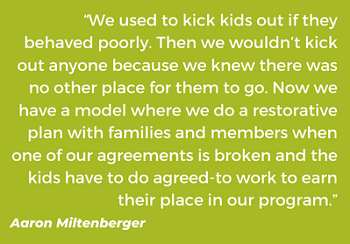
San Luis Valley/Aaron Miltenberger: We align our programs with the Alamosa School District and other local health and education efforts rather than asking youth and families to code switch between programs. We also have worked hard to become a trauma-informed program and we draw on a number of evidence-based programs, including Positive Action and Sources of Strength. Dr. Kendal García-Humes, a licensed professional counselor on our staff, helps us with planning, trains our teachers, and checks in with kids who appear to be having a hard day; he does not provide therapy. We also have partnerships with two local behavioral health providers and a referral system in place.
All of this looks pretty seamless for our kids. They begin each day in homeroom circles where they discuss what’s going on in their day. The younger kids earn stickers each week for good works, being kind and other social and emotional skills. They turn the stickers in at the end of the week for prizes. The teens like being recognized as mentors and helpers and there are other incentives, like trips, for adhering to expectations and upholding group norms.
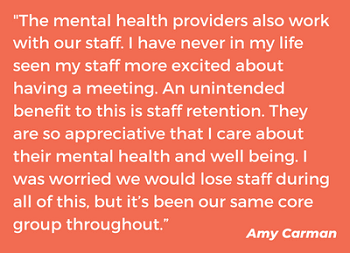
High Rockies/Amy Carman: We serve a collection of small towns and people might not be comfortable with neighbors seeing their car parked outside of a therapist’s office, so we take an integrated approach to therapy. Our parents sign waivers that are very flexible and providers to be a part of our program. Providers go on hikes with kids, do art with them, talk in small groups while playing disc golf. As a result, they become part of programming and our kids know they are safe with them and that they’re reliable. In all of our programming, we take a Positive Youth Development approach that incorporates skill-building opportunities and authentic relationships, promotes healthy behaviors and directly engages youth in implementing solutions.
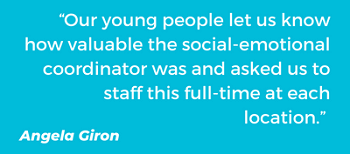
Pueblo/Angela Giron: Initially, we hired a social-emotional coordinator to serve our five locations. The problem was if someone was having a bad day on Wednesday and the social-emotional coordinator wasn’t available to them until Monday, it wasn’t as helpful. So we secured additional funding and now have a dedicated position at each of our sites. Through group activities and opportunities to interact individually with kids, their role is to give kids the tools they need to be resilient. We also have a partnership with a provider and a therapist comes to our sites each week to do therapeutic activities with the kids, assess needs, and train our staff.
How is this making a difference in the lives of young people and their families?

San Luis Valley/Aaron Miltenberger: Our assumption after two years of the pandemic was that things would get significantly better, but the behaviors of young people are worse than we’ve ever seen them before. Rates of substance abuse, truancy, suicide ideation, health concerns, calls to the Department of Human Services for referrals are all higher.
We just began a statewide art therapy pilot because we feel that young people need to find a way to process. We’re hoping that over time we can match some of the risk factors that our young people have experienced over the past two years with an equal or greater amount of protective factors that can mitigate some of that harm.

High Rockies/Amy Carman: The partnership and support we have from our school districts is making a difference. The Bailey School District does not have a social-emotional curriculum and in Fairplay they are only able to devote 45 minutes a week to social and emotional learning. Our coordinated approach means that an advocate from our program can participate in an IEP (individualized education program) visit at a young person’s school; we provide youth with help where and when it’s needed. This is especially important now because far too many kids didn’t have the support they needed during the pandemic.
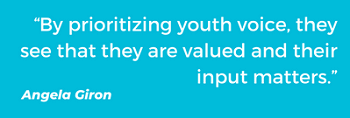
Pueblo/Angela Giron: We take teens to the Capitol to talk with state policymakers, we listen to what they have to say, and they see themselves as actors. Their voices have been the most impactful on the design and evolution of our programming. For example, we had a number of young people who identify as LGBTQ+ tell us they wanted to form a group. We supported them in doing this, providing a space for the group and engaging a therapist to join them and provide support when they meet.
What are you learning that might be helpful to other after-school programs?
San Luis Valley/Aaron Miltenberger: Consistency is king. The challenge of transitions is hard on people and has led to a mass exodus of people serving children and youth. It’s going to take a number of years to build back up to where we were pre-pandemic.
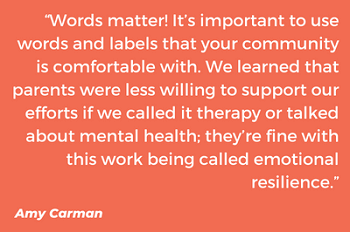
High Rockies/Amy Carman: It’s important for providers to become a part of your program. It took awhile, but now our providers are seen as “just another staff member.” This destigmatizes mental health and being cool especially matters to adolescents. Finally, staffing. By taking care of the people who care for the kids, we have had high staff retention. This means a higher level of training because we’re building on long-term, shared foundations, and this translates into higher quality care for youth.
Pueblo/Angela Giron: Many of our staff and their families also suffered during the pandemic. We provided them with mental health days, cash assistance and other supports. Our prioritization of supporting our staff was absolutely critical to their being able to support kids and help families, and we will continue this practice.
Learn more about the work of our community partners Boys & Girls Clubs of the High Rockies, Boys & Girls Clubs of Pueblo County, and Boys & Girls Clubs of the San Luis Valley to support Healthy Youth. We also welcome you to reach out to Stephanie Perez-Carrillo, Healthy Youth Statewide Philanthropy Lead for Caring for Colorado.
Pueblo Youth Action Council & YouthRoots
Accepting applications for Fall 2022

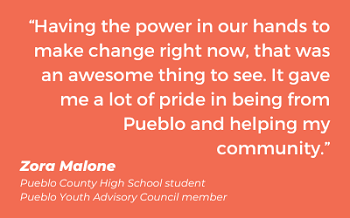
The first cohort of the Pueblo Youth Action Council wrapped up its work this spring. The inaugural class engaged nine freshmen from five Pueblo-area high schools, providing them with the opportunity to learn about philanthropy and make a difference in their community. The Sperry S. and Ella Graber Packard Fund for Pueblo, managed by Caring for Colorado, created the program in association with YouthRoots, a national effort to engage young people in leading on issues that impact their lives, particularly those furthest from the decision-making table.
Pueblo drew on the approach developed by YouthRoots, with council members first conducting a community needs assessment, followed by fundraising, soliciting grant applications, reviewing applications, interviewing applicants, and making grants. In all, they raised $18,500 and made grants to four nonprofits serving Pueblo youth: Colorado Health Network, Health Solutions, Pueblo Rape Crisis Services, and Spark the Change Colorado.
“It’s important for young people to be included in things like this because then when they’re adults they’ll know how to help out even more,” said Devin Klock, a rising sophomore at East High School who participated in the Pueblo Youth Action Council. He says he had an “a-ha” moment early in the process when reviewing findings from the needs assessment. “I realized our community is made up of so much more than just this small little area where I live.”
Zora Malone, a Pueblo County High School student who also participated in the council, said the experience provided a lot of learnings that she will carry forward. “I learned about how to conduct yourself when you meet people and ask for money, ROI, different leadership styles, and that everybody has unique strengths and can build on their weaker points.” Most of all, said Zora, the experience gave her a sense of pride. “Having the power in our hands to make change right now, that was an awesome thing to see. It gave me a lot of pride in being from Pueblo and helping my community.”
“The opportunity to participate in a high school philanthropy program developed my passion for community and led to my career in philanthropy,” said Melanie Bravo, Caring for Colorado’s Vice President of Philanthropy and head of the Packard Fund for Pueblo. “I am committed to paying that opportunity forward. After 20 years of working with and for youth, I know that young people have the power to change the world. Experiences like the Pueblo Youth Action Council inspire young people to use their talents and voice to create the kind of community they want and need to thrive.”
To learn more, we encourage you to read the Impact Report for Pueblo’s first Youth Advisory Council. Applications for the next school year are being accepted now – 2022-2023 PYAC Application. For more information, contact Melanie Bravo.
